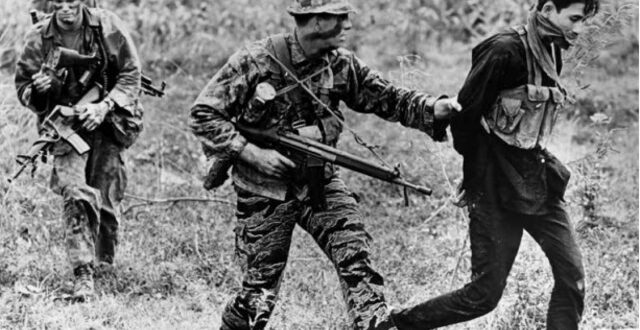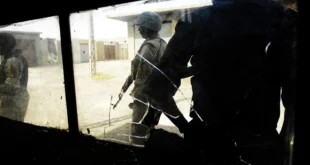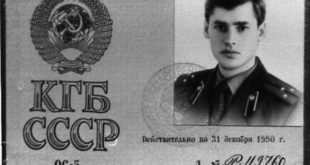by Capt. Larry Bailey, USN (Ret)
As recounted in the average personal memoir, war is most frequently depicted in combinations of heroic actions, cowardly misdeeds, triumphs of the human spirit, and the like. It ain’t always so, however; fact is, much of war is not dramatic – it’s just sad, as the following personal account demonstrates all too clearly.
In April 1967 my SEAL Team TWO platoon (one of two assigned to the so-called IV Corps area in the southernmost part of South Viet Nam) was making great strides toward carrying the war to the enemy on his own turf. As we gained more confidence in our ability to operate within Viet Cong territory, we began to conduct missions ever-farther away from our base at Can Tho, on the Bassac River. Thus it was that my squad, Three Alpha (3A), planned a particularly hairy operation much farther down-river than we had ever gone. I should point out here that East Coast SEAL platoons at that time were organized into two squads of six men; each was led by one of the two officers in the platoon.
READ MORE about U.S. forces at war in Vietnam.
According to what intelligence we could gather, the Viet Cong were staging major crossings of men and materiel across the Bassac from a village on the banks of a large canal emptying into the river. Working with personnel from Task Force 116 (the River Patrol Force) and HAL-3 (the Navy light helicopter attack squadron), we developed a plan to infiltrate the area and set up an ambush on the banks of the canal.
After developing a detailed patrol leader’s order (PLO), I briefed my squad the morning of the operation. In the afternoon we rigged our equipment and test-fired our weapons from the deck of the barge where most of our gear was stored. We went over everything from hand signals to line of march, which was as follows (names have been changed):
(1) the point man, Charlie Johnson, who could smell VC a mile away
(2) the squad leader (me)
(3) the radioman, Freddy Kirk
(4) the Vietnamese interpreter, Hoang, a truly tough Vietnamese Army sergeant
(5) the grenadier, “Gunner” Mitchell
(6) the M-60 gunner, Billy Johnson
(7) our rear-security man, Jim Harmon
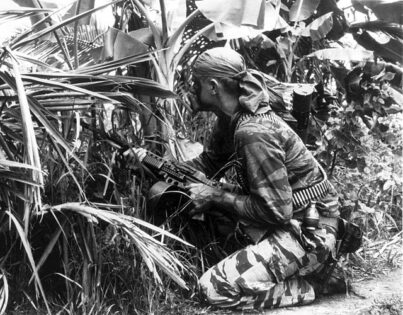
We normally included as a squad member a young Vietnamese Regional Force corporal named Truong, who dearly loved to go along with the SEALs to get VC body count. He was an intelligent young soldier with a wife and a kid or two in a nearby town, and we were glad to take him along on most of our missions. However, his problem was that he couldn’t speak any English at all, and I had briefed the squad that he would not participate in the evening’s ambush in the (correct, as it turned out) belief that, because of the difficulty of the operation, all members of the patrol had to speak English.
As we finished test-firing our weapons, a clearly distraught Truong came aboard the barge and sat down beside Jim Harmon, and began to weep. I asked Sergeant Hoang what the problem was, and he told me that Truong had “lost face” by not being included in the evening’s patrol. I then went over to Truong and, through Hoang, tried to explain why he should not come with us. Nothing worked; he only became more disconsolate.
It was so touching that the radioman, Freddy, said, “Come on, Mr. B., let him go along; he’ll be okay.”
Jim then spoke up and said that he would take him under his wing at the rear of the patrol and that he would make sure Truong “got the word” throughout the operation.
It was at this point that a well-conceived and well-planned mission began to fall apart; against my better judgment I consented to including Truong in the operation. Hoang then gave him a quick briefing on the details of the ambush, and we all went back to our quarters to grab a couple hours of sleep, have some chow, camouflage our faces, and attend to all the other pre-mission details.
I don’t mind telling you that we were all a bit more nervous than usual, because we were heading deep into “Charlie Country,” farther than any SEAL squad had ever been from its home base at that time. To get to the objective area, we boarded the two River Patrol Boats (PBR’s) assigned in support of the operation and traveled some twenty miles down-river from Can Tho to a point just offshore of the target area. After some noisy maneuvers designed to mask the true purpose of our presence in the vicinity, the boats eased their bows into the east bank of the river.
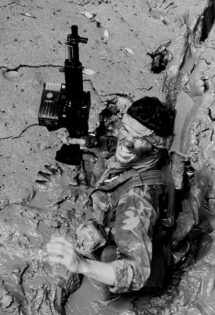
We then went “over the side” and, following standard SEAL operating procedures, laid up near the river bank for a few minutes to get our bearings and to listen to the sounds of the night for any hint of the presence of Viet Cong, which wasn’t long in coming. Just as our intelligence had indicated, there was obviously a river crossing planned, because we could hear the unmistakable sounds of sampans banging together and of engines being tested within a klick or so of our position.
After determining that our insertion had been undetected, we began a dog-leg approach to the ambush position. Upon arrival at a “rally point” (a preselected emergency rendezvous area) twenty meters or so short of the ambush site, I mustered the squad and discovered that Truong and Harmon were missing. After positioning the rest of the patrol along the canal bank, I retraced our steps in search of the missing pair.
I don’t know if you’ve ever stumbled around in hostile territory at night in head-high elephant grass looking for two well-armed, and by now highly keyed-up, patrol members. If you have, then you understand that I was also keyed-up, because I knew that I was subject to being blown away by my own men. Happily, though, I found Truong and Harmon within fifteen minutes or so and brought them back to the rally point. I then told Harmon exactly where he and Truong were to go and where everyone else was located; I then went to my own position alongside Freddy the radioman.
It must have been a couple of hours into the patrol when, as I was observing the area to our rear, I saw silhouetted against a setting moon the figures of two armed males. Thinking they might be my own men, I told Freddy, in an almost-inaudible whisper, to take a look; when he did he said in the loudest of whispers, “Mr. Bailey, it’s Truong and Harmon!”
This was not the first occasion on which Freddy had whispered too loudly while on patrol; having counseled him on how to communicate in a more secure manner, I was more than a little taken aback at his violation of patrol discipline. Predictably, both figures dropped to the ground upon hearing Freddy’s comment.
At that point one might think I had learned my lesson about consulting with Freddy on what I was seeing, but, tragically, I had not. When, an hour or so later, I saw the same two figures get up and start moving toward the right flank of the ambush position, I pointed them out to Freddy once again, whereupon he shouted that it was Truong and Harmon; once more, the two shadowy figures dropped to the ground.
When the same sequence of events happened a third time, and when I tried and failed to identify the individuals, I fired my AR-15 on full- automatic at the one nearest me, who was about eight feet away.
At that point Harmon started shouting in English, and I realized that I had made the worst mistake I could make: I had shot one of my own men. Leaping to the prostrate form before me, I saw that I had badly wounded Truong. As 3A quickly gathered ’round, I gave him mouth-to-mouth resuscitation, but, when I heard bubbles coming out his stomach every time I blew, I realized it was hopeless.
Hoang was the first to state what I didn’t want to know: “Dai Uy (Lieutenant), I think Truong die.”
Indeed he had.
The longest journey of my life was made on that moonlit, muggy night in the Mekong Delta, which commenced when I picked up Truong’s bullet-ridden body and carried it along the banks of the canal to the edge of the Bassac. It was there that one of the two PBR’s loitering offshore put its bow into the mudbank edging the river and loaded my burden and me aboard. When the other members of Squad 3A were embarked aboard the second PBR, the boats took us home; the fluvial procession resembled nothing so much as a nocturnal funeral cortege.
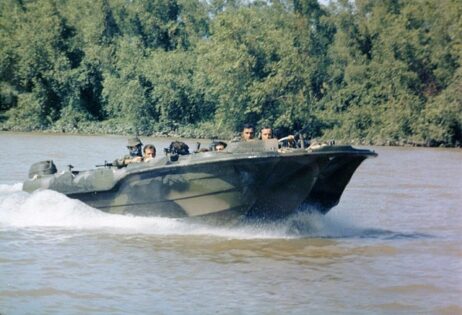
The next day Sergeant Hoang and I took Truong’s body in an Army helicopter to the little Mekong Delta town where Truong’s wife worked as a seamstress. There we delivered her husband’s body to her, along with some $300.00 which the squad had collected for her. It seemed so inappropriate at the time, but, 27 years later, I can’t think of anything we could have done differently, given the time and the circumstances within which we played our parts.
And how did the incident affect me? I think that I dealt with it as well as I could have; I rarely think about it any more. I rationalized that I had fully considered all the information available to me and had made a simple, if tragic, error in judgment. I also realized that if one of several events had not occurred, Truong’s death would not have occurred that night.
By that I mean:
(1) Freddy insisting that I let Truong come with us
(2) Harmon saying that he would be responsible for Troung’s “getting the word”
(3) My change of heart about Truong’s participation
(4) Harmon and Troung getting lost
(5) Harmon and Truong remaining at the rally point after I had told them where to position themselves in the ambush
(6) Harmon’s inexplicable violation of patrol discipline in getting up and moving around within an ambush area; and, most importantly
(7) Freddy’s loud stage whispers that prompted Harmon and Truong to “hit the deck” on three occasions, which led me to think that they were Viet Cong.
Absent any of the above, I would not have had to bury Truong. However, they happened, and, at the end of the day, it was my eleven .223-cal. rounds and nobody else’s which put an end to the life of Corporal Vy Van Truong, Regional Forces of the Army of the Republic of Viet Nam, and that is something with which I will have to deal for as long as I live.
Over the ensuing years I have done a million mental rewinds and replays of that unhappy night, asking myself how the scenario could have been altered so as to have kept Truong in this world. I always come up with the same answer: I should have stuck with my original decision not to include him in the patrol. It’s kind of funny to say it, but maybe, just maybe, I was meant to be taught a lesson that night, a lesson about having confidence in my own judgment. Any way you cut it, though, it was a bitter lesson, one I’d rather have learned differently.
Wherever you are, Truong, I wish you well. You were truly a soldier, and I was proud to have served with you. I’m just sorry things turned out the way they did.
Among his many assignments, Capt. Larry W. Bailey previously commanded Naval Special Warfare Center, and retired in 1990 from the U.S. Special Operations Command in Tampa, FL.
 Soldier of Fortune Magazine The Journal of Professional Adventurers
Soldier of Fortune Magazine The Journal of Professional Adventurers


